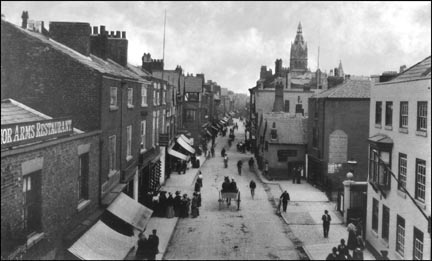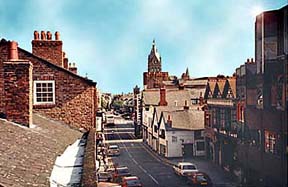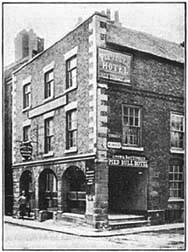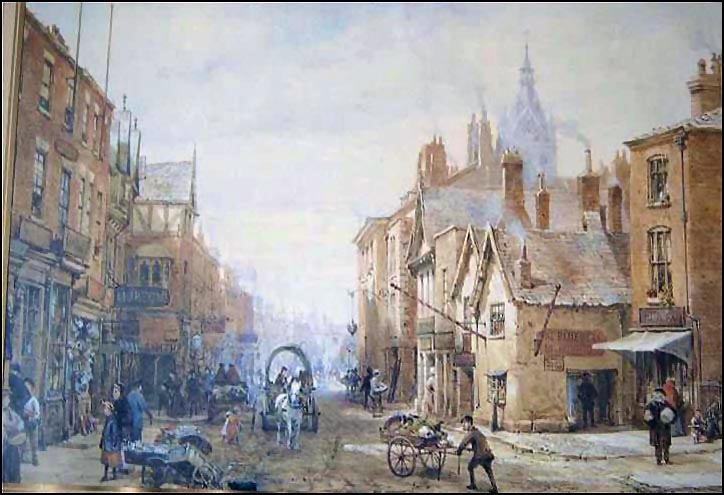Louise painted this lively scene sometime between 1880 and 1890, sitting with her back to the Northgate, and looking down Northgate Street- the Via Decumana of the Roman fortress. With the exception of a large office block standing on the site of the old Northgate Brewery (just 'out of shot' on the right) - and the inevitable heavy traffic- this part of Northgate Street has managed to retain many of its old features and the scene above will be entirely familiar to anyone who is acquainted with the area today.
 The building on the right, in the last remaining part of the vanished 12th century Lorimer's Row is the venerable Blue Bell Inn. Dispenser of refreshment to the traveller since at least 1494, when the first licence to serve ale was granted, this is the oldest 'domestic' structure in Chester, and the only surviving example of a genuine medieval inn. The braced King-Post roof points to a construction date for the present building of between 1250 and 1400, although parts of the building may date from as early as the 11th century. The building on the right, in the last remaining part of the vanished 12th century Lorimer's Row is the venerable Blue Bell Inn. Dispenser of refreshment to the traveller since at least 1494, when the first licence to serve ale was granted, this is the oldest 'domestic' structure in Chester, and the only surviving example of a genuine medieval inn. The braced King-Post roof points to a construction date for the present building of between 1250 and 1400, although parts of the building may date from as early as the 11th century.
The 'bell' may refer to the house's proximity to the Abbey (now Cathedral) and the curfew bell in the bell-yard, rung every evening to warn 'strangers' to leave the city before the gates were closed at 8pm. The brewhouse which operated within the Abbey precincts, close to the still-surviving 'Little Gateway' just across the street, may well have supplied the Bell with its beer.
During the Civil War in the 17th century, the underground cellars of the Bell were put to good use as storage for grain and other provisions, safe from the bombardment of the besieger's guns.
The unique 'cabin' extension at the front was erected in 1684 by one Elizabeth Halliwell for use as a barber's shop, which it remained until the 1920s. During the 18th century, this extension also served as a stage coach ticket office. A small window that still may be seen high on the building was once used to sell tickets to those passengers who were sitting on top of the coach.
By 1700, the ancient inn had become a house and shop, but reopened in 1807 as 'The Blue Bell' in order to distinguish it from several other inns in the vicinity with 'bell' as part of their name.
 For nearly one hundred years, from 1826, the Blue Bell was run by the Hodgson family- their name appears on the building in the painting. The last licensee was the wonderfully-named Thomas Pogmore Tushingham, from 1924-30, after which the building was bought for £1000 by the city council, who intended to demolish it for road widening. Local people would have none of it, however, and after a six-year fight, the Blue Bell was reprieved, only to be threatened again for the same reason in 1960. Around this time there was even a proposal to dismantle the entire inn and ship it to the USA! But once again, thanks to objections, it miraculously survived and for the next 22 years was the home of Snow White's clothes shop. Then, in 1984 it reverted to its ancient name and became a traditional English restaurant. For nearly one hundred years, from 1826, the Blue Bell was run by the Hodgson family- their name appears on the building in the painting. The last licensee was the wonderfully-named Thomas Pogmore Tushingham, from 1924-30, after which the building was bought for £1000 by the city council, who intended to demolish it for road widening. Local people would have none of it, however, and after a six-year fight, the Blue Bell was reprieved, only to be threatened again for the same reason in 1960. Around this time there was even a proposal to dismantle the entire inn and ship it to the USA! But once again, thanks to objections, it miraculously survived and for the next 22 years was the home of Snow White's clothes shop. Then, in 1984 it reverted to its ancient name and became a traditional English restaurant.
However, in early 2006, the venerable Blue Bell was transformed into East Glory, an oriental restaurant. Excellent though it is that eating and drinking continue here after all these centuries, it is, to our minds, unforgivable that the new tenants, in their wisdom, have swept away all trace of its ancient name.
The Blue Bell may have gone but, behind it, two other ancient inns can be seen in the painting that are very much still with us today- the Red Lion, established here since at least 1600, and the Pied Bull (right), now the oldest licenced house in Chester still serving beer. The land where it stands had originally been given by Richard the Butler around 1155 to the Nuns of St. Mary's upon the occasion of his mother, Gunnora, taking the veil and dwelling houses were erected. In 1267, Roger the Barber was granted a house here, "on the site of Le Lorimersrowe" (a lorimer was a maker of spurs) and by 1533 it seems to have been rebuilt, become the home of the Recorder of Chester, and known as Bull Mansion. Within 20 years, however, it had become an inn, Richard Grimsditch being the first publican mentioned in the Innkeeper's Accounts of 1571.

(The presence of the long-established nearby Cattle Market, swept away during the counstruction of the Inner Ring Road in the 1960s, led to a proliferation of associated pub names in the neighbourhood- the White Bull a few doors away, the Bull's Head down the street, the still-extant Bull & Stirrup outside the Northgate and the Brown Cow opposite that, as well as the Bull and Dog- now called the Liverpool Arms).
Much of the Pied Bull was again rebuilt in the 17th century and the present overhanging front was added during the 18th. The interior retains many antique features: the fine oak staircase survives from the old mansion of 1533 and an interesting 17th century painted coat of arms is preserved above the fireplace.
In the late 19th century, when the great days of coaching were drawing to a close- and this painting was made- the Pied Bull was described as "a venerable hostelry, serenely triumphing over the dust of centuries, and still one of the most respectable inns of the city".
Small shops, remarkably unchanged, still line the left hand side of Northgate Street, just they did when Louise Rayner sat outside them to paint her picture. Above all rises the tower of the great Gothic Town Hall, completed in 1869- and which we will meet again in our next painting... |

